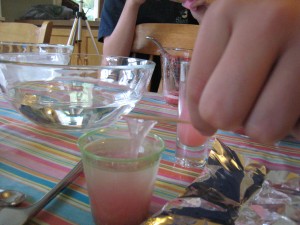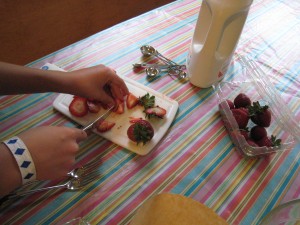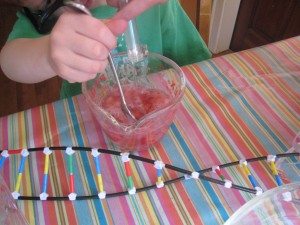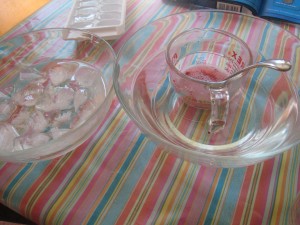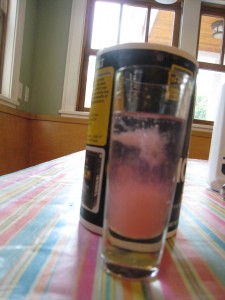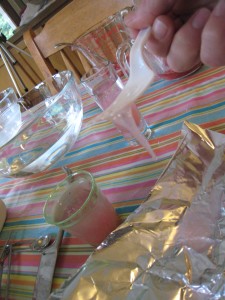Tag: DNA’
DNA Extraction Video
- by KitchenPantryScientist
Got fruit, laundry detergent, coffee filters, salt and alcohol? You can extract DNA!
Here’s a video on how to extract DNA from strawberries. This version was a little long for KidScience app, so I thought I’d post it here.
If you haven’t tried this experiment, you should! It’s a simple version of how scientists in labs really extract DNA for their research. Click here to see my original post on DNA extraction with easy directions and a little more science.
Kitchen Table DNA Extraction
- by KitchenPantryScientist
DNA, or deoxyribonucleic acid, contains all of the information needed to make every protein in a living thing and is sometimes called the “blueprint of life.”
This morning, on Kare11 Sunrise news, the kids and I showed viewers how easy it is to extract DNA from strawberries.
In higher organisms like plants and animals, DNA is stored in a compartment called a nucleus where the long, string-like DNA is tightly coiled. To separate DNA from the organism that contains it, you have to break the cells apart (lysis), filter out the big pieces of cell parts and collect the remaining liquid, or supernatent, and add chemicals like salt and alcohol to separate (precipitate) the DNA from the rest of the supernatent.
To extract DNA from strawberries at your own kitchen table, you’ll need: 3 strawberries, measuring spoons, 2 one or two-cup pyrex measuring cups, a cone-shaped coffee filter, a plastic zip-lock bag, small clear plastic or glass cups, laundry detergent (liquid or powdered), ice cubes, 2 big bowls, a timer, salt and ice-cold rubbing alcohol. *Always supervise children around cutting tools and alcohol.
Put the alcohol in the freezer at least an hour before you start the experiment so it gets cold enough to precipitate DNA. Make sure the bottle is well-labeled and you remove it when you are done since rubbing alcohol is poisonous if it is consumed by accident.
First, cut the strawberries into small pieces using a butter knife. Put the pieces in one of the pyrex measuring cups and mash them up well with a fork until you can’t see chunks any more.
Add a teaspoon of liquid or solid detergent to 1/2 cup of warm tap water, mix and pour this soapy mix over the strawberries. Fill one of the big bowls about half way with hot tap water (as hot as it comes from the faucet) and set the pyrex cup containing strawberries inside the bowl of warm water. Mix well with your fork. The detergent and warm temperature will start lysing (breaking up) the strawberry cells and proteins called enzymes will start chewing up cell parts, releasing the DNA from the nucleus. Wait 12 minutes, stirring the strawberry mixture once in a while.
Fill the other bowl about halfway with water and lots of ice cubes to make an “ice bath”. When the 12 minutes are up, set the cup containing the strawberry mixture into the ice bath for around 5 minutes, stirring once or twice. The cold temperature will slow the enzymes down so they don’t start chewing up the strawberry DNA.
While you wait, cut a plastic bag into a funnel the same size as your coffee filter and clip off the corner of the plastic bag so liquid can flow out (see photo). Put the coffee filter inside your plastic bag funnel and set the whole thing in your other pyrex measuring cup (or a wide glass.)
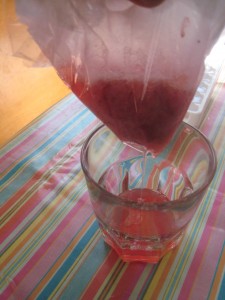
Put coffee filter inside plastic bag with tip cut off, pour strawberry mixture in and collect the supernatent.
When the 5 minutes are up, pour the strawberry solution into the filter/funnel and hold it while the strawberry gunk is filtered out and the supernatent containing the DNA flow through and into the cup below. If your filter gets clogged, use a spoon to carefully remove some of the strawberry gunk so more liquid can flow through. Don’t worry if you don’t collect every drop.
Now you get to precipitate the DNA! Pour some supernatent into your small, clear glass until it is about 1/3 full. Add about 1/4 teaspoon salt to the supernatant and mix it up well with a spoon or knife. Now, gently pour an equal volume (the same amount as your supernatent) of ice-cold alcohol into your supernatent. Do not mix it, but put your hand over the top of the glass and rock it gently. Set it down on the table and let it sit for a few minutes.
You should see a cloudy goo forming near the top of the liquid. It may look bubbly or slightly white. This is strawberry DNA.
You can use a toothpick or plastic fork to gently lift the DNA from the glass. It will look like clear slime.
Put it on a plate and touch it… how does it feel?
Congratulation scientist! You’ve just extracted DNA from a living organism!
*If you don’t see DNA, make sure you’ve added the salt. You can also set the entire glass in the freezer for half an hour if your alcohol wasn’t cold enough and the DNA should precipitate out!
Jurassic Park- Closer Than We Think?
- by KitchenPantryScientist
When I told my husband that scientists at the J.Craig Venter Institute had assembled a funtioning bacterium from bottles of chemicals, he said exactly what I was thinking. “It’s like The Stand.” Even if you’re not a Stephen King fan, you’ve probably heard of his novel where a genetically engineered strain of the flu virus wipes out almost every human on earth.
USA Today, on the other hand, said “The long-anticipated advance, reported in the journal Science, is a $40 million milestone in the nascent field of “synthetic biology” and points towards a future of designer microbes manufacturing fuels, chemicals and materials.”
The news that a synthetic bacterium has been created comes as no surprise to most scientists. Even when I worked in a lab ten years ago, we cut and pasted bacterial DNA together on a regular basis. We also synthesized relatively short pieces of DNA by pushing buttons on a machine. The technology has vastly improved since then, and entire bacterial genomes have been sequenced. Scientists know exactly what it takes to make a functioning bacterial cell.
Some good and bad uses for synthetic biology immediately spring to mind:
Good things: Scientists may be able to design bacteria that specifically target certain areas of the human bodies, so that the bacteria could colonize those areas (say, the intestine) and produce and deliver drugs to specific organs without causing harm. You could even turn drug delivery on and off by putting “inducible promoters” which are basically on/off switches, in front of the genes for drug production. You could possibly use the technology to deliver chemotherapy directly to tumors too, if you could create bacteria that recognize and bind to certain proteins produced by tumor cells.
Bad, bad things: Bioweapons. Scientists could potentially piece together nasty bacterial bioweapons that could survive sunlight and even radiation. (Most natural bacteria are relatively fragile and difficult to “disperse” or spread through the air.)
Nature has some controls of her own. Bacteria must contain certain elements to survive and replicate, and sometimes putting foreign DNA into a bacterium will kill it. There are also size limits.
We can only hope that the good that comes from this technological breakthrough outweighs the bad. Later today, I’m planning to pre-order tickets for an amusement park where you’ll be able to see real live dinosaurs in about 20 years.
